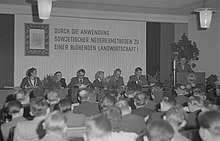Innovation
The Newer beings , even innovation movement called, was in the German Democratic Republic , a State-controlled process (DDR) to help with suggestions for improvement of the working people , the productivity increase. The East German innovator system resembled the internal suggestion scheme in the Federal Republic of Germany .
The innovation is to be distinguished from the possibility of submitting written or verbal suggestions, information, concerns and complaints in accordance with the law on the processing of citizens' submissions for informal conflict resolution, for example in the case of management bodies, state- owned enterprises and combines and socialist cooperatives .
Terms
Neuerer ( loan translation from Russian новатор, nowator ) was a term in the GDR for an inventor , discoverer or researcher at universities and scientific institutions, in factories , combines and agricultural production cooperatives , who made suggestions for improving work processes, improving machines and systems , to save material, energy, work equipment and manpower, i.e. for rationalization .
The term innovator was only used systematically in the GDR from the early 1960s to replace the terms common in the field of suggestion systems in the Federal Republic of Germany . The suggestion for improvement was called the innovator proposal , the submitter innovator and the totality of all measures with which the working people participated in the socialist rationalization, innovator movement .
history
Innovation was very important in the GDR. Even before it was founded in the Soviet occupation zone , it was officially brought into being with the decree on the promotion of inventiveness and the evaluation of the company suggestion system of September 15, 1948, in order to make a noticeable contribution to increasing labor productivity.
It was last regulated in the innovator ordinance from 1971, the validity of which ended with the announcement of the repeal of the innovator movement on August 8, 1990 a few months before reunification .
Since 1963, innovator activity has included innovator proposals and innovator agreements .
- Newer suggestions were handled in a similar way to the suggestions for improvement in the company suggestion scheme in the West .
- Innovator agreements were used to solve more complex problems and were roughly comparable to what the West called quality circles.
Allowances
The remuneration that innovators received for implemented innovations ranged from 30 to 30,000 GDR marks , with the percentage share of the remuneration in the first-year benefit falling from 16% to 1,000 marks for benefits to 0.5% for benefits of more than 1,000,000 marks . For a first year use of 100,000 marks, for example, the remuneration was 3,120 marks. However, in exceptional cases (special importance, economic or operational focus, exemplary use, especially in the case of collective innovator activity), this remuneration could be tripled. Thus the theoretical maximum premium was 90,000 marks.
Others
In all larger companies there were offices for the innovator movement (BfN). A part-time processor at the BfN was sufficient for up to 500 employees. In addition, at least one full-time processor was required for every 1,000 employees or part thereof. Additional academic training was offered for these workers at the universities.
The innovation was part of the planned economy with detailed specifications about the number of proposals to be achieved in the individual companies and their economic benefits. The high participation figures prove the propaganda , social significance, but reflect less of the real economic benefit. In 1965 there were 409,000 innovator suggestions (NV) with a stated benefit of over 1.2 billion GDR marks , and in 1988 even 440,000 NV with a given benefit of more than 6.2 billion GDR marks.
The mass of the masters of tomorrow was also part of the GDR's innovation . In 1988, 51,200 such trade fairs were held and over 850,000 exhibits created by innovative young people were displayed. The monthly magazine Der Neuerer - magazine for invention and suggestion system was published by the office for invention and patent system of the GDR , which was responsible as the highest authority for the control of the innovator movement. The magazine was published from 1952 to 1990.
The innovation system was a political issue in the GDR and at that time had a much higher priority than the company suggestion system in the Federal Republic of Germany. The extremely high and not easily measurable expenditure for state funding for innovators did not appear anywhere in the official GDR statistics. The real benefits, however, should at least have borne the costs of the innovator movement.
See also
Literature and Sources
- FDGB-Lexikon, Berlin 2009 Retrieved November 16, 2016
- Law Gazette of the German Democratic Republic, January 14, 1972, Part II No. 1, pp. 1–11. Facsimile (PDF file 3.4 MB)
Individual evidence
- ^ A b c d e Peter Koblank: The innovation of the GDR. The most important facts about the socialist variant of idea management , November 2012, available online in: Best of Koblank .
- ^ Ordinance on the promotion of the activities of innovators and rationalizers in the innovator movement - Neuererverordnung - of December 22, 1971 , Law Gazette of the German Democratic Republic, January 14, 1972, Part II No. 1, pp. 1-11. Facsimile (PDF file; 3.4 MB).
- ↑ a b State Central Administration for Statistics (Ed.): Statistical Yearbook of the German Democratic Republic - 1989 . Staatsverlag der DDR, Berlin 1989, p. 131 f.
- ↑ Hartmann, Martin: The innovator movement. The company suggestion scheme in the GDR . Cologne 1988, p. 154.


